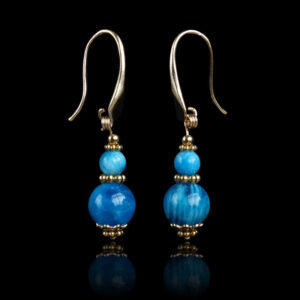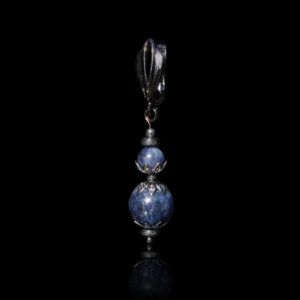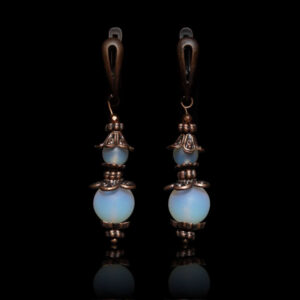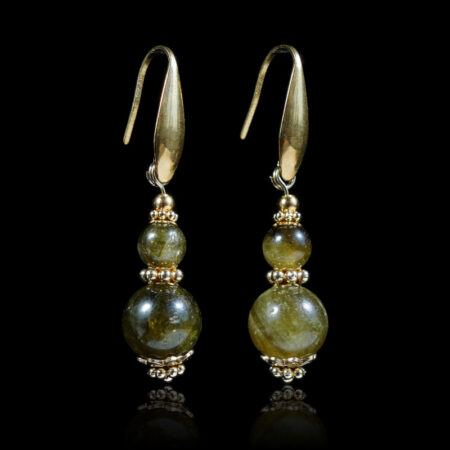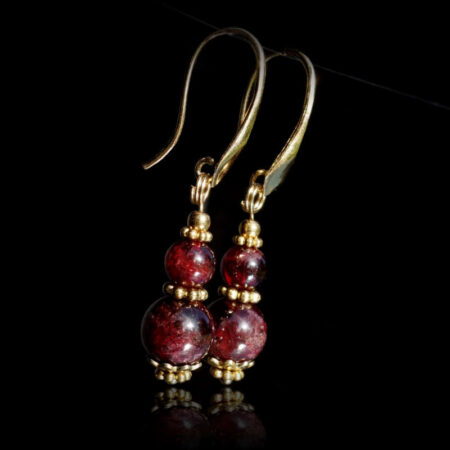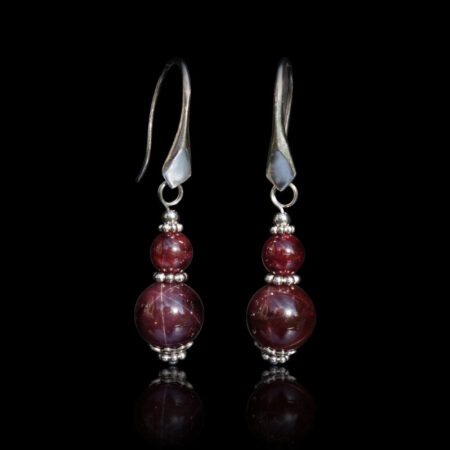Your cart is currently empty!
-
-
Earrings
-
Necklaces
-
Bracelets
-
Rosary
-
Birthstones
-
Zodiac
-
a – z
-
Colour
COMING SOON!
I am currently working on classic Rosary necklaces aka prayer beads with beautiful round semi-precious stone beads and PVD plated gold finish stainless steel beads, gold plated iron caps, original design centrepieces and crosses.
Centrepieces come with four design options: two Orthodox crosses, the messenger dove, and the Sacred Heart.
Currently I’m waiting on a shipment of Dyneema thread to make the cordage indestructible. Miyuki thread was too fragile, Cotton Mouliné is nice, but let’s try something even more robust.
Keep a look out for my new rosaries with fantastic stone beads such as Ruby, Peridot, Larimar, Tanzanite, Sapphire, Emerald, Diopside, Apatite, Agate, Onyx, Amethyst, Rose Quartz, Rhodonite, Amazonite, Turquoise, Jasper, Pyrite, Shell, Aventurine, Pietersite;

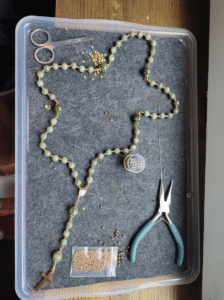

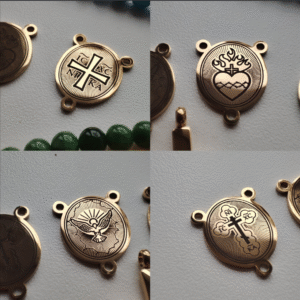


January
The Birthstones of January are
Garnet, Rose Quartz, Hyacinth;
“With each new doorway, let go of what was and step fully into what is. True vision comes from being present at the threshold.”
Transitions, duality, and beginnings – Janus
March
The Birthstones of March are
Blood Jasper, Heliotrope, Tourmaline & Vesuvianite
“Victory comes not in battle, but in mastering your own impulses. True courage is found in acting without reactivity, with calm purpose.”
Courage, action, and assertiveness – Mars/Ares
April
The Birthstones of April are
Diamond, Rock Crystal & Sapphire
“Love is not something to seek, but a beauty you create through kindness, like flowers blossoming in the spring.”
Love, Beauty, and Creation – Venus/Aphrodite
May
The Birthstones of May are
Chrome Diopside, Chrysoprase & Emerald
“Growth is not hurried. Like the earth, allow your heart to nurture what it holds, and abundance will follow in time.”
Growth, Nurturing, and Abundance – Maia
June
The birthstones of June are
Chalcedony, Moonstone & Pearl
“True connection is built on mutual care—love is strengthened when you protect and encourage each other to grow.”
Marriage, Family, and Protection – Juno/hera
August
The Birthstones of August are
Onyx, & Sardonyx
“The Sun shines for all, unconditionally. Let your truth be a light that heals and unites.”
Light, Healing, and Truth – Apollo
September
The Birthstones of September are
Cat’s Eye, Strawberry Quartz & Peridot
“Mastery is found in quiet persistence—like the forge, each trial shapes you into something stronger and more refined.”
Work, Craftmanship, and Inner Strength – Vulcan/Haephaestus
October
The Birthstones of October are Aquamarine & Opal, Opalite*, Strawberry Quartz
“As the veil thins and the old year fades, remember that true wisdom lies in accepting endings, for they are the soil where new life will take root.”
Wisdom, Endings, and Transformation – Cailleach/Samhain
November
The Birthstones of November are
Pietersite / Eagle’s Eye, Tiger’s Eye & Topaz
“Power lies in embracing change—like the seasons, let go of what has died to make room for new growth.”
Transformation, Power, and the Underworld – Pluto/Hades
December
The Birthstones of December are Chrysoprase, Larimar*, Tanzanite* & Turquoise
“Time has a special property: Moments can be immortal, echoing through our hearts when we choose to cherish them fully in the present.”
Time, Discipline, and Wisdom – Saturn/Cronus
January
The Birthstones of January are
Garnet, Rose Quartz, Hyacinth;
“With each new doorway, let go of what was and step fully into what is. True vision comes from being present at the threshold.”
Transitions, duality, and beginnings – Janus
March
The Birthstones of March are
Blood Jasper, Heliotrope, Tourmaline & Vesuvianite
“Victory comes not in battle, but in mastering your own impulses. True courage is found in acting without reactivity, with calm purpose.”
Courage, action, and assertiveness – Mars/Ares
April
The Birthstones of April are
Diamond, Rock Crystal & Sapphire
“Love is not something to seek, but a beauty you create through kindness, like flowers blossoming in the spring.”
Love, Beauty, and Creation – Venus/Aphrodite
May
The Birthstones of May are
Chrome Diopside, Chrysoprase & Emerald
“Growth is not hurried. Like the earth, allow your heart to nurture what it holds, and abundance will follow in time.”
Growth, Nurturing, and Abundance – Maia
June
The birthstones of June are
Chalcedony, Moonstone & Pearl
“True connection is built on mutual care—love is strengthened when you protect and encourage each other to grow.”
Marriage, Family, and Protection – Juno/hera
August
The Birthstones of August are
Onyx, & Sardonyx
“The Sun shines for all, unconditionally. Let your truth be a light that heals and unites.”
Light, Healing, and Truth – Apollo
September
The Birthstones of September are
Cat’s Eye, Strawberry Quartz & Peridot
“Mastery is found in quiet persistence—like the forge, each trial shapes you into something stronger and more refined.”
Work, Craftmanship, and Inner Strength – Vulcan/Haephaestus
October
The Birthstones of October are Aquamarine & Opal, Opalite*, Strawberry Quartz
“As the veil thins and the old year fades, remember that true wisdom lies in accepting endings, for they are the soil where new life will take root.”
Wisdom, Endings, and Transformation – Cailleach/Samhain
November
The Birthstones of November are
Pietersite / Eagle’s Eye, Tiger’s Eye & Topaz
“Power lies in embracing change—like the seasons, let go of what has died to make room for new growth.”
Transformation, Power, and the Underworld – Pluto/Hades
December
The Birthstones of December are Chrysoprase, Larimar*, Tanzanite* & Turquoise
“Time has a special property: Moments can be immortal, echoing through our hearts when we choose to cherish them fully in the present.”
Time, Discipline, and Wisdom – Saturn/Cronus
Aries
Tropical: March 21 – April 19
Sidereal: April 14 – May 13
“True strength is not in charging ahead, but in knowing when to stand still and listen.”
Aries Zodiac Stones are
Bloodstone, Carnelian, Chalcedony, Chrysoprase, Kyanite, Red Jasper, Ruby & Tanzanite
Taurus
Tropical: April 20 – May 20
Sidereal: May 14 – June 19
“Like the steady earth, your resilience is your power—root yourself in what truly matters.”
Taurus Zodiac Stones are
Amber, Aventurine, Carnelian, Coral, Emerald, Kyanite, Lapis Lazuli, Lava Stone, Quartz, Rhodonite, Rose Quartz, Sapphire, Sard & Topaz
Gemini
Tropical: May 21 – June 20
Sidereal: June 20 – July 20
“To see both sides is not to be divided; it is to understand the wholeness of life’s dualities.”
Gemini Zodiac Stones are
Agate, Aquamarine, Chrysocolla, Chalcedony, Citrine, Diopside, Jasper, K2 Granite, Onyx, Pietersite, Rock Crystal, Russian Serpentine, Tiger’s Eye, Topaz & Turquoise
Cancer
Tropical: June 21 – July 22
Sidereal: July 21 – August 10
“The shell protects, but do not forget to let love in—your vulnerability is your greatest strength.”
Cancer Zodiac Stones are
Aventurine, Carnelian, White Chalcedony, Chrysoprase, Diamond, Emerald, Lava Stone, Moonstone, Peridot, Rhodochrosite & Rhodonite
Leo
Tropical: July 23 – August 22
Sidereal: August 11 – September 15
“The lion does not seek the sun, for it knows it shines within—radiate your inner light without fear.”
Leo Zodiac Stones are
Amber, Carnelian, Chrysolite, Cinnabar, Citrine, Diamond, Garnet, Gold Quartz, Larimar, Onyx, Pietersite, Rhodochrosite, Rock Crystal & Ruby
Libra
Tropical: September 23 – October 22
Sidereal: October 31 – November 22
“Balance is not about holding still; it is the graceful dance between give and take.”
Libra Zodiac Stones are
Aventurine, Beryl, Citrine, Diamond, Emerald, Fuchsite, Jade, Kunzite, Kyanite, Lapis Lazuli, Nephrite, Opal*, Opalite*, Orange Citrine, Peridot, Prehnite, Sardonyx, Smoky Quartz, Strawberry Quartz, Topaz & Rose Tourmaline
Scorpio
Tropical: October 23 – November 21
Sidereal: November 23 – November 29
“True transformation requires going deep—do not fear the dark, for it holds your greatest truths.”
Scorpio Zodiac Stones are
Agate, Aquamarine, Carnelian, Chalcedony, Chrysoprase, Garnet, Obsidian, Rhodochrosite, Ruby, Smoky Quartz & Topaz
Sagittarius
Tropical: November 22 – December 21
Sidereal: December 18 – January 18
“Adventure is not a destination, but the spirit of curiosity you carry within—every step is a journey.”
Sagittarius Zodiac Stones are
Amethyst, Beryl, Chalcedony, Garnet, Pyrope, Quartz, Rock Crystal, Sapphire, Spinel, Sodalite, Tanzanite, Topaz & Vesuvianite
Capricorn
Tropical: December 22 – January 19
Sidereal: January 19 – February 15
“Mountains are climbed with patience and persistence—your steady ascent is what makes the peak meaningful.”
Capricorn Zodiac Stones are
Agate, Amethyst, Beryl, Cat’s-Eye, Malachite, Obsidian, Onyx, Peridot, Prehnite, Quartz, Rose Quartz, Ruby, Smoky Quartz, Green Tourmaline & Vesuvianite
Aquarius
Tropical: January 20 – February 18
Sidereal: February 16 – March 11
“Freedom is found not in breaking away from others, but in connecting with the vastness of your own mind.”
Aquarius Zodiac Stones are
Amazonite, Amethyst, Aquamarine, Celestine, Chrysocolla, Coral, Garnet, Hawk’s Eye, Jasper, Malachite, Obsidian, Pietersite Eagle’s Eye, Sapphire & Turquoise
Pisces
Tropical: 19. February – 20. March
Sidereal: 12. March – 13. April
“Like water, flow with life’s currents—there is wisdom in yielding, and strength in moving with grace.”
Pisces Zodiac Stones are
Amethyst, Aquamarine, Chrome Diopside, Coral, Diamond, Jade, Moonstone, Opal*, Opalite*, Quartz, Sapphire, Sugilite & Tanzanite
Ophiuchus*
Tropical: Not traditionally included
Sidereal: November 30 – December 17
“Embrace the serpent’s wisdom—knowledge heals, and through understanding, we find our path.”
Ophiuchus* Zodiac Stones* are
Amethyst, Citrine, Turquoise, Labradorite, and Ruby
Notes
13th Sign: Ophiuchus is often considered in sidereal astrology because the Sun does pass through this constellation, but it’s not part of the traditional 12-sign zodiac used in Western astrology.
Note on Stones: The concept of birthstones for Ophiuchus is not as standardized as for the traditional zodiac signs since Ophiuchus isn’t part of the tropical zodiac. However, these stones are often associated with Ophiuchus due to their metaphysical properties that align with the characteristics attributed to this sign in sidereal astrology. Amethyst for spirituality and intuition, Citrine for abundance and positivity, Turquoise for healing and communication, Labradorite for transformation and intuition, and Ruby for passion and motivation.
Aries
Tropical: March 21 – April 19
Sidereal: April 14 – May 13
“True strength is not in charging ahead, but in knowing when to stand still and listen.”
Aries Zodiac Stones are
Bloodstone, Carnelian, Chalcedony, Chrysoprase, Kyanite, Red Jasper, Ruby & Tanzanite
Taurus
Tropical: April 20 – May 20
Sidereal: May 14 – June 19
“Like the steady earth, your resilience is your power—root yourself in what truly matters.”
Taurus Zodiac Stones are
Amber, Aventurine, Carnelian, Coral, Emerald, Kyanite, Lapis Lazuli, Lava Stone, Quartz, Rhodonite, Rose Quartz, Sapphire, Sard & Topaz
Gemini
Tropical: May 21 – June 20
Sidereal: June 20 – July 20
“To see both sides is not to be divided; it is to understand the wholeness of life’s dualities.”
Gemini Zodiac Stones are
Agate, Aquamarine, Chrysocolla, Chalcedony, Citrine, Diopside, Jasper, K2 Granite, Onyx, Pietersite, Rock Crystal, Russian Serpentine, Tiger’s Eye, Topaz & Turquoise
Cancer
Tropical: June 21 – July 22
Sidereal: July 21 – August 10
“The shell protects, but do not forget to let love in—your vulnerability is your greatest strength.”
Cancer Zodiac Stones are
Aventurine, Carnelian, White Chalcedony, Chrysoprase, Diamond, Emerald, Lava Stone, Moonstone, Peridot, Rhodochrosite & Rhodonite
Leo
Tropical: July 23 – August 22
Sidereal: August 11 – September 15
“The lion does not seek the sun, for it knows it shines within—radiate your inner light without fear.”
Leo Zodiac Stones are
Amber, Carnelian, Chrysolite, Cinnabar, Citrine, Diamond, Garnet, Gold Quartz, Larimar, Onyx, Pietersite, Rhodochrosite, Rock Crystal & Ruby
Libra
Tropical: September 23 – October 22
Sidereal: October 31 – November 22
“Balance is not about holding still; it is the graceful dance between give and take.”
Libra Zodiac Stones are
Aventurine, Beryl, Citrine, Diamond, Emerald, Fuchsite, Jade, Kunzite, Kyanite, Lapis Lazuli, Nephrite, Opal*, Opalite*, Orange Citrine, Peridot, Prehnite, Sardonyx, Smoky Quartz, Strawberry Quartz, Topaz & Rose Tourmaline
Scorpio
Tropical: October 23 – November 21
Sidereal: November 23 – November 29
“True transformation requires going deep—do not fear the dark, for it holds your greatest truths.”
Scorpio Zodiac Stones are
Agate, Aquamarine, Carnelian, Chalcedony, Chrysoprase, Garnet, Obsidian, Rhodochrosite, Ruby, Smoky Quartz & Topaz
Ophiuchus*
Tropical: Not traditionally included
Sidereal: November 30 – December 17
“Embrace the serpent’s wisdom—knowledge heals, and through understanding, we find our path.”
Ophiuchus* Zodiac Stones* are
Amethyst, Citrine, Turquoise, Labradorite, and Ruby
Notes
13th Sign: Ophiuchus is often considered in sidereal astrology because the Sun does pass through this constellation, but it’s not part of the traditional 12-sign zodiac used in Western astrology.
Note on Stones: The concept of birthstones for Ophiuchus is not as standardized as for the traditional zodiac signs since Ophiuchus isn’t part of the tropical zodiac. However, these stones are often associated with Ophiuchus due to their metaphysical properties that align with the characteristics attributed to this sign in sidereal astrology. Amethyst for spirituality and intuition, Citrine for abundance and positivity, Turquoise for healing and communication, Labradorite for transformation and intuition, and Ruby for passion and motivation.
Sagittarius
Tropical: November 22 – December 21
Sidereal: December 18 – January 18
“Adventure is not a destination, but the spirit of curiosity you carry within—every step is a journey.”
Sagittarius Zodiac Stones are
Amethyst, Beryl, Chalcedony, Garnet, Pyrope, Quartz, Rock Crystal, Sapphire, Spinel, Sodalite, Tanzanite, Topaz & Vesuvianite
Capricorn
Tropical: December 22 – January 19
Sidereal: January 19 – February 15
“Mountains are climbed with patience and persistence—your steady ascent is what makes the peak meaningful.”
Capricorn Zodiac Stones are
Agate, Amethyst, Beryl, Cat’s-Eye, Malachite, Obsidian, Onyx, Peridot, Prehnite, Quartz, Rose Quartz, Ruby, Smoky Quartz, Green Tourmaline & Vesuvianite
Aquarius
Tropical: January 20 – February 18
Sidereal: February 16 – March 11
“Freedom is found not in breaking away from others, but in connecting with the vastness of your own mind.”
Aquarius Zodiac Stones are
Amazonite, Amethyst, Aquamarine, Celestine, Chrysocolla, Coral, Garnet, Hawk’s Eye, Jasper, Malachite, Obsidian, Pietersite Eagle’s Eye, Sapphire & Turquoise
Pisces
Tropical: 19. February – 20. March
Sidereal: 12. March – 13. April
“Like water, flow with life’s currents—there is wisdom in yielding, and strength in moving with grace.”
Pisces Zodiac Stones are
Amethyst, Aquamarine, Chrome Diopside, Coral, Diamond, Jade, Moonstone, Opal*, Opalite*, Quartz, Sapphire, Sugilite & Tanzanite
Semi-precious Gems
Silica/QUartz
Natural
-
-
Earrings
-
Necklaces
-
Bracelets
-
Rosary
-
Birthstones
-
Zodiac
-
A to Z
-
Colour
COMING SOON!
I am currently working on classic Rosary necklaces aka prayer beads with beautiful round semi-precious stone beads and PVD plated gold finish stainless steel beads, gold plated iron caps, original design centrepieces and crosses.
Centrepieces come with four design options: two Orthodox crosses, the messenger dove, and the Sacred Heart.
Currently I’m waiting on a shipment of Dyneema thread to make the cordage indestructible. Miyuki thread was too fragile, Cotton Mouliné is nice, but let’s try something even more robust.
Keep a look out for my new rosaries with fantastic stone beads such as Ruby, Peridot, Larimar, Tanzanite, Sapphire, Emerald, Diopside, Apatite, Agate, Onyx, Amethyst, Rose Quartz, Rhodonite, Amazonite, Turquoise, Jasper, Pyrite, Shell, Aventurine, Pietersite;






January
The Birthstones of January are
Garnet, Rose Quartz, Hyacinth;
“With each new doorway, let go of what was and step fully into what is. True vision comes from being present at the threshold.”
Transitions, duality, and beginnings – Janus
March
The Birthstones of March are
Blood Jasper, Heliotrope, Tourmaline & Vesuvianite
“Victory comes not in battle, but in mastering your own impulses. True courage is found in acting without reactivity, with calm purpose.”
Courage, action, and assertiveness – Mars/Ares
April
The Birthstones of April are
Diamond, Rock Crystal & Sapphire
“Love is not something to seek, but a beauty you create through kindness, like flowers blossoming in the spring.”
Love, Beauty, and Creation – Venus/Aphrodite
May
The Birthstones of May are
Chrome Diopside, Chrysoprase & Emerald
“Growth is not hurried. Like the earth, allow your heart to nurture what it holds, and abundance will follow in time.”
Growth, Nurturing, and Abundance – Maia
June
The birthstones of June are
Chalcedony, Moonstone & Pearl
“True connection is built on mutual care—love is strengthened when you protect and encourage each other to grow.”
Marriage, Family, and Protection – Juno/hera
August
The Birthstones of August are
Onyx, & Sardonyx
“The Sun shines for all, unconditionally. Let your truth be a light that heals and unites.”
Light, Healing, and Truth – Apollo
September
The Birthstones of September are
Cat’s Eye, Strawberry Quartz & Peridot
“Mastery is found in quiet persistence—like the forge, each trial shapes you into something stronger and more refined.”
Work, Craftmanship, and Inner Strength – Vulcan/Haephaestus
October
The Birthstones of October are Aquamarine & Opal, Opalite*, Strawberry Quartz
“As the veil thins and the old year fades, remember that true wisdom lies in accepting endings, for they are the soil where new life will take root.”
Wisdom, Endings, and Transformation – Cailleach/Samhain
November
The Birthstones of November are
Pietersite / Eagle’s Eye, Tiger’s Eye & Topaz
“Power lies in embracing change—like the seasons, let go of what has died to make room for new growth.”
Transformation, Power, and the Underworld – Pluto/Hades
December
The Birthstones of December are Chrysoprase, Larimar*, Tanzanite* & Turquoise
“Time has a special property: Moments can be immortal, echoing through our hearts when we choose to cherish them fully in the present.”
Time, Discipline, and Wisdom – Saturn/Cronus
January
The Birthstones of January are
Garnet, Rose Quartz, Hyacinth;
“With each new doorway, let go of what was and step fully into what is. True vision comes from being present at the threshold.”
Transitions, duality, and beginnings – Janus
March
The Birthstones of March are
Blood Jasper, Heliotrope, Tourmaline & Vesuvianite
“Victory comes not in battle, but in mastering your own impulses. True courage is found in acting without reactivity, with calm purpose.”
Courage, action, and assertiveness – Mars/Ares
April
The Birthstones of April are
Diamond, Rock Crystal & Sapphire
“Love is not something to seek, but a beauty you create through kindness, like flowers blossoming in the spring.”
Love, Beauty, and Creation – Venus/Aphrodite
May
The Birthstones of May are
Chrome Diopside, Chrysoprase & Emerald
“Growth is not hurried. Like the earth, allow your heart to nurture what it holds, and abundance will follow in time.”
Growth, Nurturing, and Abundance – Maia
June
The birthstones of June are
Chalcedony, Moonstone & Pearl
“True connection is built on mutual care—love is strengthened when you protect and encourage each other to grow.”
Marriage, Family, and Protection – Juno/hera
August
The Birthstones of August are
Onyx, & Sardonyx
“The Sun shines for all, unconditionally. Let your truth be a light that heals and unites.”
Light, Healing, and Truth – Apollo
September
The Birthstones of September are
Cat’s Eye, Strawberry Quartz & Peridot
“Mastery is found in quiet persistence—like the forge, each trial shapes you into something stronger and more refined.”
Work, Craftmanship, and Inner Strength – Vulcan/Haephaestus
October
The Birthstones of October are Aquamarine & Opal, Opalite*, Strawberry Quartz
“As the veil thins and the old year fades, remember that true wisdom lies in accepting endings, for they are the soil where new life will take root.”
Wisdom, Endings, and Transformation – Cailleach/Samhain
November
The Birthstones of November are
Pietersite / Eagle’s Eye, Tiger’s Eye & Topaz
“Power lies in embracing change—like the seasons, let go of what has died to make room for new growth.”
Transformation, Power, and the Underworld – Pluto/Hades
December
The Birthstones of December are Chrysoprase, Larimar*, Tanzanite* & Turquoise
“Time has a special property: Moments can be immortal, echoing through our hearts when we choose to cherish them fully in the present.”
Time, Discipline, and Wisdom – Saturn/Cronus
Aries
Tropical: March 21 – April 19
Sidereal: April 14 – May 13
“True strength is not in charging ahead, but in knowing when to stand still and listen.”
Aries Zodiac Stones are
Bloodstone, Carnelian, Chalcedony, Chrysoprase, Kyanite, Red Jasper, Ruby & Tanzanite
Taurus
Tropical: April 20 – May 20
Sidereal: May 14 – June 19
“Like the steady earth, your resilience is your power—root yourself in what truly matters.”
Taurus Zodiac Stones are
Amber, Aventurine, Carnelian, Coral, Emerald, Kyanite, Lapis Lazuli, Lava Stone, Quartz, Rhodonite, Rose Quartz, Sapphire, Sard & Topaz
Gemini
Tropical: May 21 – June 20
Sidereal: June 20 – July 20
“To see both sides is not to be divided; it is to understand the wholeness of life’s dualities.”
Gemini Zodiac Stones are
Agate, Aquamarine, Chrysocolla, Chalcedony, Citrine, Diopside, Jasper, K2 Granite, Onyx, Pietersite, Rock Crystal, Russian Serpentine, Tiger’s Eye, Topaz & Turquoise
Cancer
Tropical: June 21 – July 22
Sidereal: July 21 – August 10
“The shell protects, but do not forget to let love in—your vulnerability is your greatest strength.”
Cancer Zodiac Stones are
Aventurine, Carnelian, White Chalcedony, Chrysoprase, Diamond, Emerald, Lava Stone, Moonstone, Peridot, Rhodochrosite & Rhodonite
Leo
Tropical: July 23 – August 22
Sidereal: August 11 – September 15
“The lion does not seek the sun, for it knows it shines within—radiate your inner light without fear.”
Leo Zodiac Stones are
Amber, Carnelian, Chrysolite, Cinnabar, Citrine, Diamond, Garnet, Gold Quartz, Larimar, Onyx, Pietersite, Rhodochrosite, Rock Crystal & Ruby
Libra
Tropical: September 23 – October 22
Sidereal: October 31 – November 22
“Balance is not about holding still; it is the graceful dance between give and take.”
Libra Zodiac Stones are
Aventurine, Beryl, Citrine, Diamond, Emerald, Fuchsite, Jade, Kunzite, Kyanite, Lapis Lazuli, Nephrite, Opal*, Opalite*, Orange Citrine, Peridot, Prehnite, Sardonyx, Smoky Quartz, Strawberry Quartz, Topaz & Rose Tourmaline
Scorpio
Tropical: October 23 – November 21
Sidereal: November 23 – November 29
“True transformation requires going deep—do not fear the dark, for it holds your greatest truths.”
Scorpio Zodiac Stones are
Agate, Aquamarine, Carnelian, Chalcedony, Chrysoprase, Garnet, Obsidian, Rhodochrosite, Ruby, Smoky Quartz & Topaz
Sagittarius
Tropical: November 22 – December 21
Sidereal: December 18 – January 18
“Adventure is not a destination, but the spirit of curiosity you carry within—every step is a journey.”
Sagittarius Zodiac Stones are
Amethyst, Beryl, Chalcedony, Garnet, Pyrope, Quartz, Rock Crystal, Sapphire, Spinel, Sodalite, Tanzanite, Topaz & Vesuvianite
Capricorn
Tropical: December 22 – January 19
Sidereal: January 19 – February 15
“Mountains are climbed with patience and persistence—your steady ascent is what makes the peak meaningful.”
Capricorn Zodiac Stones are
Agate, Amethyst, Beryl, Cat’s-Eye, Malachite, Obsidian, Onyx, Peridot, Prehnite, Quartz, Rose Quartz, Ruby, Smoky Quartz, Green Tourmaline & Vesuvianite
Aquarius
Tropical: January 20 – February 18
Sidereal: February 16 – March 11
“Freedom is found not in breaking away from others, but in connecting with the vastness of your own mind.”
Aquarius Zodiac Stones are
Amazonite, Amethyst, Aquamarine, Celestine, Chrysocolla, Coral, Garnet, Hawk’s Eye, Jasper, Malachite, Obsidian, Pietersite Eagle’s Eye, Sapphire & Turquoise
Pisces
Tropical: 19. February – 20. March
Sidereal: 12. March – 13. April
“Like water, flow with life’s currents—there is wisdom in yielding, and strength in moving with grace.”
Pisces Zodiac Stones are
Amethyst, Aquamarine, Chrome Diopside, Coral, Diamond, Jade, Moonstone, Opal*, Opalite*, Quartz, Sapphire, Sugilite & Tanzanite
Ophiuchus*
Tropical: Not traditionally included
Sidereal: November 30 – December 17
“Embrace the serpent’s wisdom—knowledge heals, and through understanding, we find our path.”
Ophiuchus* Zodiac Stones* are
Amethyst, Citrine, Turquoise, Labradorite, and Ruby
Notes
13th Sign: Ophiuchus is often considered in sidereal astrology because the Sun does pass through this constellation, but it’s not part of the traditional 12-sign zodiac used in Western astrology.
Note on Stones: The concept of birthstones for Ophiuchus is not as standardized as for the traditional zodiac signs since Ophiuchus isn’t part of the tropical zodiac. However, these stones are often associated with Ophiuchus due to their metaphysical properties that align with the characteristics attributed to this sign in sidereal astrology. Amethyst for spirituality and intuition, Citrine for abundance and positivity, Turquoise for healing and communication, Labradorite for transformation and intuition, and Ruby for passion and motivation.
Aries
Tropical: March 21 – April 19
Sidereal: April 14 – May 13
“True strength is not in charging ahead, but in knowing when to stand still and listen.”
Aries Zodiac Stones are
Bloodstone, Carnelian, Chalcedony, Chrysoprase, Kyanite, Red Jasper, Ruby & Tanzanite
Taurus
Tropical: April 20 – May 20
Sidereal: May 14 – June 19
“Like the steady earth, your resilience is your power—root yourself in what truly matters.”
Taurus Zodiac Stones are
Amber, Aventurine, Carnelian, Coral, Emerald, Kyanite, Lapis Lazuli, Lava Stone, Quartz, Rhodonite, Rose Quartz, Sapphire, Sard & Topaz
Gemini
Tropical: May 21 – June 20
Sidereal: June 20 – July 20
“To see both sides is not to be divided; it is to understand the wholeness of life’s dualities.”
Gemini Zodiac Stones are
Agate, Aquamarine, Chrysocolla, Chalcedony, Citrine, Diopside, Jasper, K2 Granite, Onyx, Pietersite, Rock Crystal, Russian Serpentine, Tiger’s Eye, Topaz & Turquoise
Cancer
Tropical: June 21 – July 22
Sidereal: July 21 – August 10
“The shell protects, but do not forget to let love in—your vulnerability is your greatest strength.”
Cancer Zodiac Stones are
Aventurine, Carnelian, White Chalcedony, Chrysoprase, Diamond, Emerald, Lava Stone, Moonstone, Peridot, Rhodochrosite & Rhodonite
Leo
Tropical: July 23 – August 22
Sidereal: August 11 – September 15
“The lion does not seek the sun, for it knows it shines within—radiate your inner light without fear.”
Leo Zodiac Stones are
Amber, Carnelian, Chrysolite, Cinnabar, Citrine, Diamond, Garnet, Gold Quartz, Larimar, Onyx, Pietersite, Rhodochrosite, Rock Crystal & Ruby
Libra
Tropical: September 23 – October 22
Sidereal: October 31 – November 22
“Balance is not about holding still; it is the graceful dance between give and take.”
Libra Zodiac Stones are
Aventurine, Beryl, Citrine, Diamond, Emerald, Fuchsite, Jade, Kunzite, Kyanite, Lapis Lazuli, Nephrite, Opal*, Opalite*, Orange Citrine, Peridot, Prehnite, Sardonyx, Smoky Quartz, Strawberry Quartz, Topaz & Rose Tourmaline
Scorpio
Tropical: October 23 – November 21
Sidereal: November 23 – November 29
“True transformation requires going deep—do not fear the dark, for it holds your greatest truths.”
Scorpio Zodiac Stones are
Agate, Aquamarine, Carnelian, Chalcedony, Chrysoprase, Garnet, Obsidian, Rhodochrosite, Ruby, Smoky Quartz & Topaz
Ophiuchus*
Tropical: Not traditionally included
Sidereal: November 30 – December 17
“Embrace the serpent’s wisdom—knowledge heals, and through understanding, we find our path.”
Ophiuchus* Zodiac Stones* are
Amethyst, Citrine, Turquoise, Labradorite, and Ruby
Notes
13th Sign: Ophiuchus is often considered in sidereal astrology because the Sun does pass through this constellation, but it’s not part of the traditional 12-sign zodiac used in Western astrology.
Note on Stones: The concept of birthstones for Ophiuchus is not as standardized as for the traditional zodiac signs since Ophiuchus isn’t part of the tropical zodiac. However, these stones are often associated with Ophiuchus due to their metaphysical properties that align with the characteristics attributed to this sign in sidereal astrology. Amethyst for spirituality and intuition, Citrine for abundance and positivity, Turquoise for healing and communication, Labradorite for transformation and intuition, and Ruby for passion and motivation.
Sagittarius
Tropical: November 22 – December 21
Sidereal: December 18 – January 18
“Adventure is not a destination, but the spirit of curiosity you carry within—every step is a journey.”
Sagittarius Zodiac Stones are
Amethyst, Beryl, Chalcedony, Garnet, Pyrope, Quartz, Rock Crystal, Sapphire, Spinel, Sodalite, Tanzanite, Topaz & Vesuvianite
Capricorn
Tropical: December 22 – January 19
Sidereal: January 19 – February 15
“Mountains are climbed with patience and persistence—your steady ascent is what makes the peak meaningful.”
Capricorn Zodiac Stones are
Agate, Amethyst, Beryl, Cat’s-Eye, Malachite, Obsidian, Onyx, Peridot, Prehnite, Quartz, Rose Quartz, Ruby, Smoky Quartz, Green Tourmaline & Vesuvianite
Aquarius
Tropical: January 20 – February 18
Sidereal: February 16 – March 11
“Freedom is found not in breaking away from others, but in connecting with the vastness of your own mind.”
Aquarius Zodiac Stones are
Amazonite, Amethyst, Aquamarine, Celestine, Chrysocolla, Coral, Garnet, Hawk’s Eye, Jasper, Malachite, Obsidian, Pietersite Eagle’s Eye, Sapphire & Turquoise
Pisces
Tropical: 19. February – 20. March
Sidereal: 12. March – 13. April
“Like water, flow with life’s currents—there is wisdom in yielding, and strength in moving with grace.”
Pisces Zodiac Stones are
Amethyst, Aquamarine, Chrome Diopside, Coral, Diamond, Jade, Moonstone, Opal*, Opalite*, Quartz, Sapphire, Sugilite & Tanzanite
Semi-precious Gems
Silica/QUartz
Natural
FILTERS
Product Search
Filter by Price
Main Stone
Finish
Base Metal
Clasp
Hook Type
Birthstone
Zodiac Stone
Colour
Garnet
“Passion without fear is strength; strength without love is empty. Find the balance.”
Birthstone of January
Zodiac Stone of Aquarius, Leo, Sagittarius & Scorpio
Cosmic Junction: Pluto, Mars, Sun
Names: Almandine, carbuncle, cinnamon stone, Bohemian ruby, pyrope, starlight garnet, spessartine, grossular.
Garnet’s Properties:
Wealth through Transformation and Redemption
Garnet conducts and amplifies transformative and redemptive energies. Garnet is Awakened when the Sun is in the constellations Aquarius, Leo, Sagittarius and Scorpio, or in the planet Pluto:
Garnet’s Origin Story:
Sabaoth, once Yaldabaoth’s heir, forged garnet’s deep red under Mars’ fiery wrath to fuel Anger (150/1000). Its embers were meant to bind souls to parasitic enemies, draining loosh through endless strife. The stone’s glow fed the demiurge’s chaos, chaining sparks to futile battles.
Zoe, ever merciful, saw Sabaoth’s potential. With Norea and Saint Mary Magdalene’s redemptive love, she invited him to Pleroma’s light. Sabaoth recast garnet, aligning it with the Sun’s radiant purpose. Its fire now burned for freedom.
Garnet became a spiritual pirate’s antifragile strategy, embracing intentional loss of small battles to win the war. It defies parasitic foes, urging seekers to redeem their inner fire. Norea, while reincarnating in the Tartarus, recovers the garnet souls of the damned that become a part of her light army headed to conquer Saturn – TIME.
Garnet fuels the solar plexus chakra’s astral body, where Anger (150/1000) binds souls. It sparks Willingness (310/1000), shifting attitudes to strategic patience—an Adlerian choice to lose small fights for greater gain. Thriving in strife, it fosters Courage (200/1000). Spiritual pirates wield garnet to redeem and free sparks.
“Redemption turns embers to eternal flame.”



